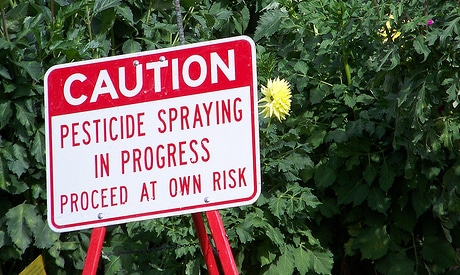
Weeds are one of the top enemies of any farmer. As a result, the makers of GMO seeds make big promises to farmers about weed management. Monsanto, the leading manufacturer of GMO seeds, claims on its website that it can offer corn farmers “the ability to control weeds and pests with a single seed through a process known as trait stacking.” But at what price?
In reality what has happened is that herbicide use on corn, soybeans and cotton, the three biggest GMO crops, increased by 26 percent between 2001 and 2010, as a Food & Water Watch report found. The reason is simple. As weeds developed resistance to the herbicide glyphosate, farmers just applied more and more.
For the report titled Superweeds: How Biotech Crops Bolster the Pesticide Industry, Food & Water Watch examined USDA and EPA data to determine the use of herbicides alongside the adoption of herbicide-tolerant GMO crops. What the advocacy group found is that the total volume of the herbicide glyphosate applied to the three biggest GMO crops increased 10-fold from 1996 to 2012. Almost all corn, soybean and cotton fields today are sprayed with glyphosate. Read more about pesticides
Food & Water Watch also found that herbicide resistant weeds, also known as superweeds, have increased.
Currently, there are 14 weed species resistant to glyphosate in the U.S. and 24 species globally. The estimates by the agriculture industry are that 61.2 million acres of cropland are infested with glyphosate resistant weeds. Over a quarter (27 percent) of U.S. farmers reported more than one glyphosate resistant weed species in their fields in 2012, almost twice as many as the year before. Weed resistance has increased. In 2008, glyphosate resistant waterhemp was reported in five states, but in 2012 it was reported in 12 states. Glyphosate resistant Palmer amaranth was reported in only eight states in 2008, but in 17 states in 2012. The presence of glyphosate resistant horseweed increased from 12 states in 2004 to 21 in 2012.
Herbicide resistant weeds are expensive for farmers. The cost ranges from $12 to $50 an acre, or as much as $12,000 for an average sized corn or soybean farm, or $28,000 for an average cotton farm. However, the crop protection industry, which includes seed and chemical companies, grows as a result of weed resistance. The global crop protection market tripled from $26 billion in 2001 to $64 billion in 2012, and herbicides account for half of those sales. The global GMO seed market increased from $115 million in 1996 when it began to $15 billion in 2012, a 130-fold increase. Read more about GMOs and how to avoid them
Herbicides are toxic for the environment and for people. Studies published this year linked herbicides to Parkinson’s Disease and depression. Clearly, something needs to be done to protect the American people. The report recommends that the federal government and the agencies that are supposed to protect the American people need to reform the approval process for GMO crops. Until that policy is created, the U.S. should place a moratorium on any new approvals of GMO plants and animals.
Photo Credit: jetsandzeppelins




